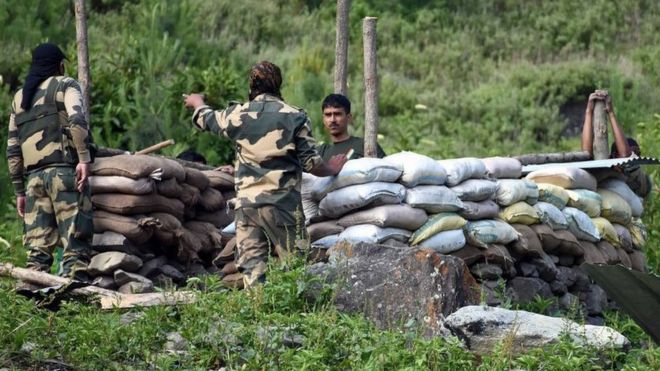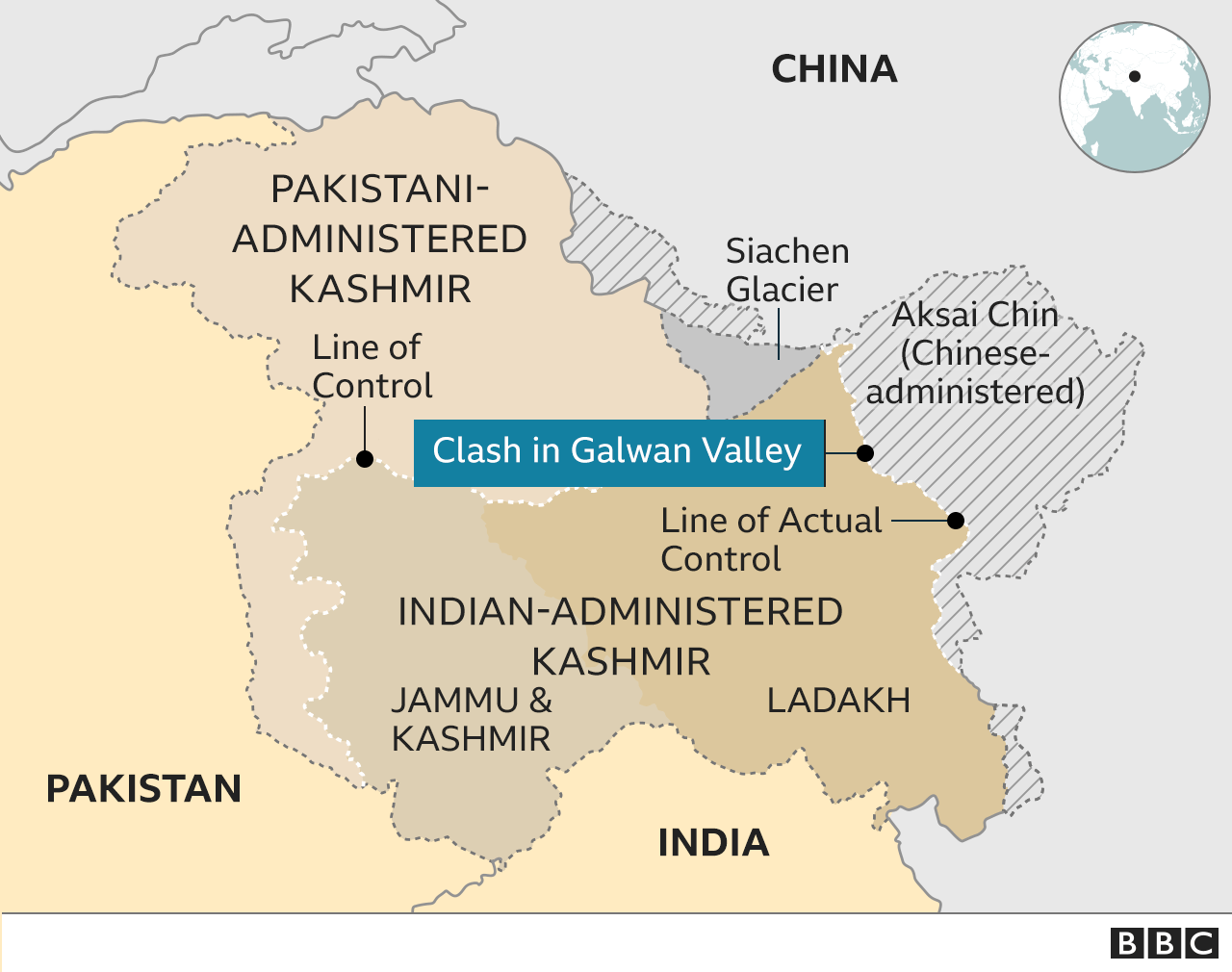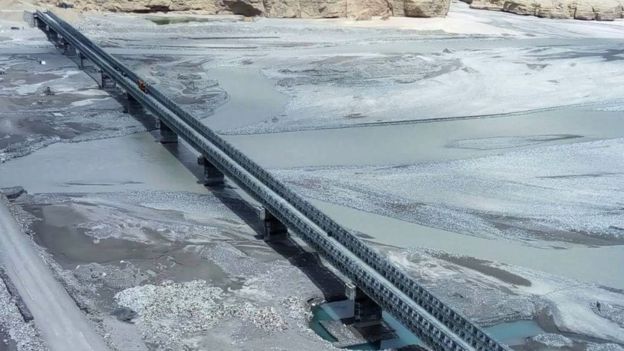老美搞事搵老襯,
莫廸糊塗為拍馬,
懶理睦隣亂咁冚。
不費半彈已經咁,
用槍咁就更不堪,
今時比六二還徑,
奉勸阿三諗再諗。

印軍魂斷
阿三哥, 周圍惹火, 真係唔明阿廸哥點諗!幾十年已經左霸右霸好多西邊地, 就連錫金都滅埋人地王朝, 你攞咁多荒山做乜嘢, 唔通地下好多黃金???
照片中的印度陸軍上校團長, 無端端帶了一百來個兵越過邊界來拆中國守軍野外帳篷,結果被伏擊,一百來個抓了一半,五十個,到目前還留了俩在中國軍手裡,老共只有五個輕傷。

印軍"帳亡"之處,左手邊PLA野外帳蓬
據英國權威BBC報導,印軍二十員"帳亡"!

印度陣亡上校及其下屬
莫廸, 執政莫敵, 金融, 經濟, 衛生都莫能為力, 唯有轉移視綫去為敵大漢, 可惜一出手莫能懟敵, 又不敢真的為敵!
BBC消息, 這次衝突, 印度“陣亡”二十人, 都是石頭, 棍球, “差呢事”功夫而斃亡, 雙方未發一槍。
India-China clash: 20 Indian troops killed in Ladakh fighting
 GETTY IMAGES
GETTY IMAGES
At least 20 Indian soldiers were killed in a clash with Chinese forces in a disputed Himalayan border area, Indian officials say.
The incident follows rising tensions, and is the first deadly clash in the border area in at least 45 years.
The Indian army initially said three of its soldiers had been killed, adding that both sides suffered casualties.
But later on Tuesday, officials said a number of critically injured soldiers had died of their wounds.
India's external affairs ministry accused China of breaking an agreement struck the previous week to respect the Line of Actual Control (LAC) in the Galwan Valley.
BBC diplomatic correspondent James Robbins says violence between two armies high up in the Himalayas is very serious, and pressure will grow on the two nuclear powers not to allow a slide into full-scale conflict.
What have both sides said about the incident?
Early on Tuesday the Indian army said three of its soldiers, including an officer, had died in a clash in Ladakh, in the disputed Kashmir region.
Later in the day, it released a statement saying the two sides had disengaged.
It added that "17 Indian troops who were critically injured in the line of duty" and died from their injuries, taking the "total that were killed in action to 20".
China did not confirm any casualties, but accused India in turn of crossing the border onto the Chinese side.
Chinese foreign ministry spokesman Zhao Lijian said India had crossed the border twice on Monday, "provoking and attacking Chinese personnel, resulting in serious physical confrontation between border forces on the two sides", AFP news agency reported.

Both sides insist no bullet has been fired in four decades, and the Indian army said on Tuesday that "no shots were fired" in this latest skirmish.
How a clash that did not involve an exchange of fire could prove so lethal is unclear. There are reports that it was fought with rocks and clubs
Local media outlets reported that the Indian soldiers had been "beaten to death".
How tense is the area?
The LAC is poorly demarcated. The presence of rivers, lakes and snowcaps means the line can shift. The soldiers either side - representing two of the world's largest armies - come face to face at many points.
- India-China border row explained in 400 words
- Why tensions are rising between the neighbours
- How a new map stirred old rivalries
But there have been tense confrontations along the border in recent weeks.
India has accused China of sending thousands of troops into Ladakh's Galwan valley and says China occupies 38,000sq km (14,700sq miles) of its territory. Several rounds of talks in the last three decades have failed to resolve the boundary disputes.
The two countries have fought only one war so far, in 1962, when India suffered a humiliating defeat.
In May, dozens of Indian and Chinese soldiers exchanged physical blows on the border in the north-eastern state of Sikkim. And in 2017, the two countries clashed in the region after China tried to extend a border road through a disputed plateau.
 PRESS INFORMATION BUREAU
PRESS INFORMATION BUREAU
There are several reasons why tensions are rising now - but competing strategic goals lie at the root, and both sides blame each other.
India has built a new road in what experts say is the most remote and vulnerable area along the LAC in Ladakh. And India's decision to ramp up infrastructure seems to have infuriated Beijing.
The road could boost Delhi's capability to move men and materiel rapidly in case of a conflict.
India also disputes part of Kashmir - an ethnically diverse Himalayan region covering about 140,000sq km - with Pakistan.


The two nuclear armed neighbours have a chequered history of face-offs and overlapping territorial claims along the more than 3,440km (2,100 mile), poorly drawn Line of Actual Control separating the two sides.
Border patrols have often bumped into each other, resulting in occasional scuffles. But no bullets have been fired in four decades.
That is why Sunday's night's clash following months of roiling tension has taken many by surprise.
Whatever the result, the latest incident is likely to trigger a fresh wave of anti-China sentiments in India.
It will also present daunting foreign policy and security challenges to Indian Prime Minister Narendra Modi and his government, which is struggling to contain a surge of Covid-19 infections and revive an economy which looks headed for recession.


